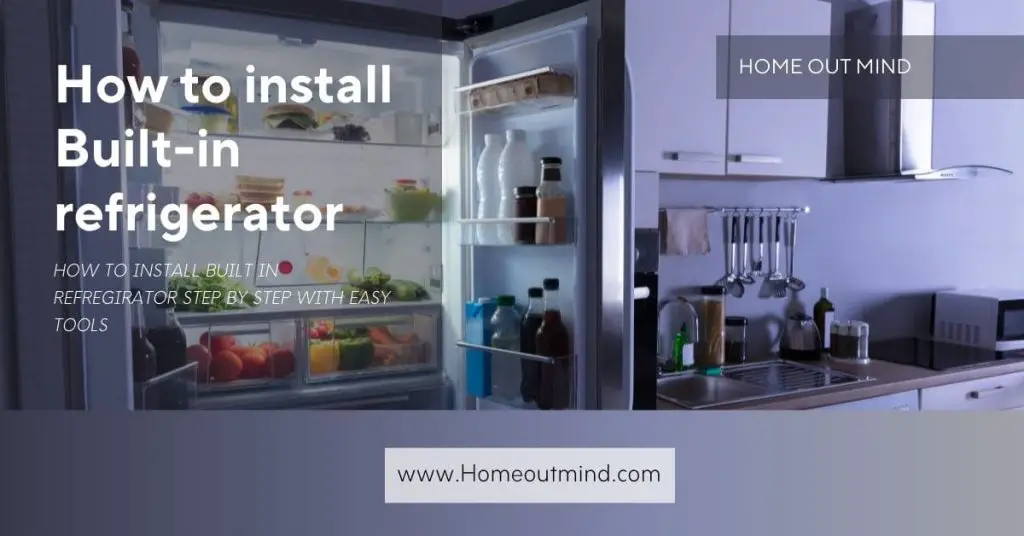are you wondering how to install built-in refrigerator? is this your first time trying to install a built-in refrigerator and you don’t know how? don’t worry you’re in the right place.
In this article we’ll show how to install built-in refrigerator Step-By-Step in easy ways, so please follow these steps and instructions below.

Before installation:
- check the cabinet defects and installation environment
- make certain that the floor under the unit is clear and level with the surrounding flooring and can support the
- weight of the refrigerator and contents included which is at least 600 pounds.
- check the cabinet specifications power socket location installation space and ventilation space
Tools you will need:
- Water line fixer and screws
- Coupler
- Water line
- Water filter lock-clip
- Water filter
- Check valve
- Phillips screwdriver
- Flat-head screwdriver
- Socket spanner
- Allen spanner
- Parts and tools required
How to install built-in refrigerator Step-By-Step
Step1. Width of the required opening
the finished opening must be square plumb and level the width of the required opening varies by model but is:
- 35-1/2” to 35-3/4” for 36” units.
- 41-1/2” to 41-1/2” to 41-3/4” for 42” units.
- 47-1/2” to 47-3/4” for 48” units.
The location must permit all doors and drawers to open freely and without obstruction according to the clearance measurements outlined in the installation guide.
for corner wall conditions an additional minimum clearance distance of 5 inches is required.
more clearance may be required if you are installing custom overlay panels custom handles or extended handles.
installation requires a minimum of six inches of open space above the grill panel or above a false front when present
the refrigerator is designed to vent out the front at the top of the upper vent grill a minimum of a half-inch of clearance is needed above the top grill for ventilation and to be able to remove grill after installation.
standard installation requires a solid soffit or cabinet bottom eighty-four inches above the floor if a soffit or cabinet isn’t available or higher than 84 inches then the refrigerator must be braced with anti-tip boards.
anti-tip boards are not provided with the product and should be measured and installed from pieces of 2×4 wood boards and be long enough to fully cover the width of the housing.
the anti-tip boards must overlap the rear of the compressor housing by at least two inches locate and Mark all stud locations on the rear wall 80 to 90 inches above the floor.
Important: Before drilling make certain there are no electrical wires or plumbing behind the wall that the screws could penetrate.
depending on the depth of the opening cut and attach one or more two-by-four wood boards to as many wall studs as possible with wood screws making certain the wood screws have sufficient length to penetrate the studs by at least one and one-half inches.
Step2. connecting the water supply
the water supply shut-off valve should be located in a base cabinet on either side of the refrigerator or other easily accessible area.
if a saddle-type valve meets with local plumbing codes your refrigerator dealer has a kit available that contains a 1/4 inch saddle valve with a union and copper tubing, water supply lines may come up through the floor or through cabinet sides.
for cabinet conditions the access hole through the cabinet must be within:
1/2 inch of the rear wall for floor conditions a half-inch hole should be drilled within the rectangular area that is at least six inches from either side and no more than one inch from the back wall.
a cold water supply with water pressure between 30 and 120 psi is required to operate the ice maker.
1. extend the waterline beyond the opening by using flexible tubing if it complies with local codes
it’s not recommended for the ice maker to be connected to a softened water supply
before attaching the water tubing to the refrigerator flush the water supply line to remove any particles or air from the line and check for leaks.
2. allow enough water to flow so that the water becomes clear.
3. allow at least 26 inches of flexible water tubing to be loose at the front of the refrigerator for connecting to the refrigerator.
4. tape the tubing to the floor along its length 7 inches from the left side of the refrigerator so that it will pass underneath without interference.
Step3. Remove trim to reduce tipping radius
1. remove and set aside any literature
The side trims give a finished edge on each side of the refrigerator this trim overlaps the face of the cabinetry if you do not have the adequate ceiling height to stand the refrigerator upright the tipping radius can be reduced by removing the top grille and side trims.
2. remove the trim
- removing the grille panel grasp both ends of the top grille.
- pull out at the bottom of the grille to release the clips.
- lift the grille straight up.
- lay the grille on a soft surface.
- turn the master power switch to off or disconnect power at the circuit breaker.
3. remove the six screws attaching each cabinet side trim to the refrigerator, and remove the side trim.
Notes:
Do not remove the tape door bracing or the protective film until the refrigerator is in its final operating location.
If the unit has been laid on its back or side allows it to stand upright for a minimum of 24 hours before connecting power.
a unit that must move its side must be left side leaned and transported left side down.
Step4. Plugging in refrigerator
Make sure the switch at the top of the cabinet is in the off position
following the National Electrical Code and local code ordinances when installing the receptacle.
- A 115 volt, 60 Hz., AC only, 15- or 20-amp fused, grounded electrical supply required.
an isolated circuit in the electrical panel or breaker box that serves only the refrigerator is recommended a grounded three-prong electrical outlet should be located at the proper distance above the floor and from the right side cabinetry or end wall.
avoid using an outlet that is controlled by a switch or has ground fault circuit interrupter or GFCI protection as this could result in nuisance tripping.
- plug into a grounded three prong outlet
Step5. Install the refrigerator into the cabinet
1. roll the refrigerator straight back slowly and evenly into the opening
2. Take care not to scratch the surrounding cabinetry with any part of the unit that protrudes or may have sharp edges.
3. check to be sure the water supply line isn’t kinked and that the power cord is on top of the refrigerator.
Step6. Leveling the refrigerator
all four leveling legs must contact the floor to support and stabilize the full weight of the refrigerator.
- use a 5/16 inch socket driver to turn the leveling bolts clockwise to extend the front and rear legs to the floor.
- continuing to rotate the leveling bolts clockwise will raise that corner of the refrigerator, while rotating counter clockwise will lower that corner of the refrigerator.
- continue to gradually adjust both sets of leveling bolts so that the refrigerator is level left to right and front to back and aligned with the adjacent cabinets.
engage the anti-tip boards by continuing to raise the refrigerator evenly until the top of the refrigerator is making contact with the bottom of the anti-tip boards.
the leveling legs only extend to a maximum of 1 and 1/4 inches below the rollers.
Step6.
connect the water supply line to the refrigerator.
Step7.
turn on the water supply and check all connections for leaks.
Step8. Adjust refrigerator door
door swing comes set at 130 degrees with an option of 110 or 90 degrees Settings panel ready models come set to 110 degrees if door adjustments are required to achieve the proper
1. Use a Phillips screwdriver to unscrew the hinge covers on the top of each door.
2. Open the doors to loosen the hinges and remove the hinge covers. Once the covers are removed, close the doors.
3. Disconnect the electrical harness.
4. Unscrew the hinge screws counterclockwise, and remove the upper hinge. Be careful as the door can fall on you, causing physical injury.
5. Remove the hinges on both sides.
6. Gently lift up the doors one by one to remove them.
Use caution as the door may fall off or over.
Step9. Install the base grill
there are two pieces to the base grille assembly to allow for a custom fit
1. remove the film from the base grille and snap the skirt onto the grille if necessary.
2. to sides the grille properly, score the skirt at the appropriate V groove with a utility knife, and then break the skirt at the scoreline.
3. attach the base grille assembly to the refrigerator right side
- using the two black screws provided.
4. turn the refrigerator switch to the on position to install the top grille panel hook the grille panel brackets onto the top mounting pins.
- pull down to snap the spring clips over lower mounting the pins
remove any remaining protective film remove all packing material from inside the refrigerator and the installation site.
Read also:
- How to change air filter in LG refrigerator?
- How to clean refrigerator water filter?
- How to remove Samsung refrigerator doors?
- How to clean condenser coils on ge profile refrigerator?
- How to install refrigerator?
- How to replace a refrigerator compressor?
Step10.
install any shelves and bins removed during installation.
check to the compressor and all lights are operating properly controls are preset by the factory to the midpoint adjust as needed.
Step11.
turn on the ice maker and the water system will flush through normal operation.
Note: it could take up to 24 hours to make the first batch of ice

